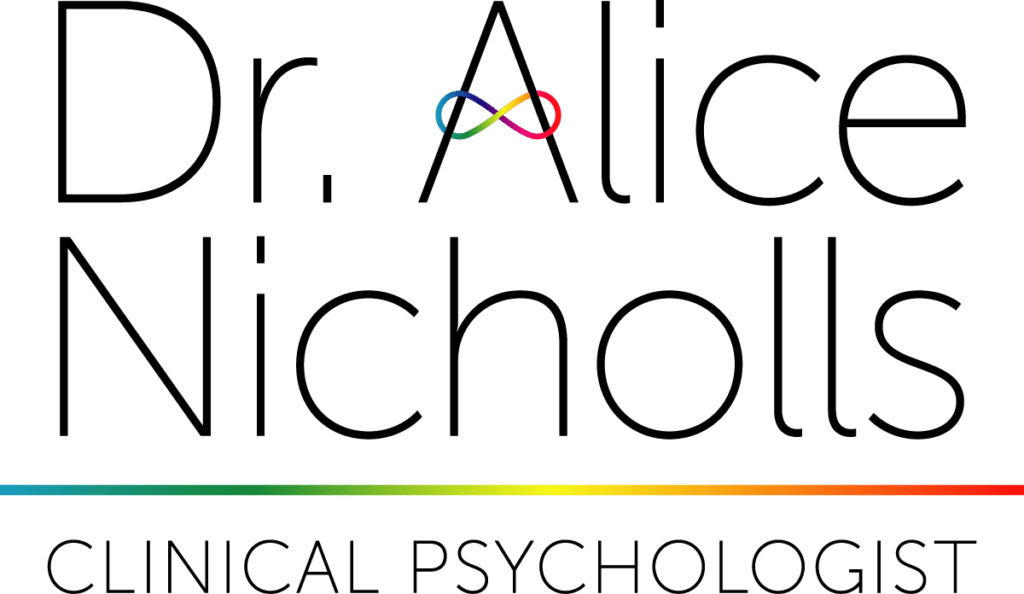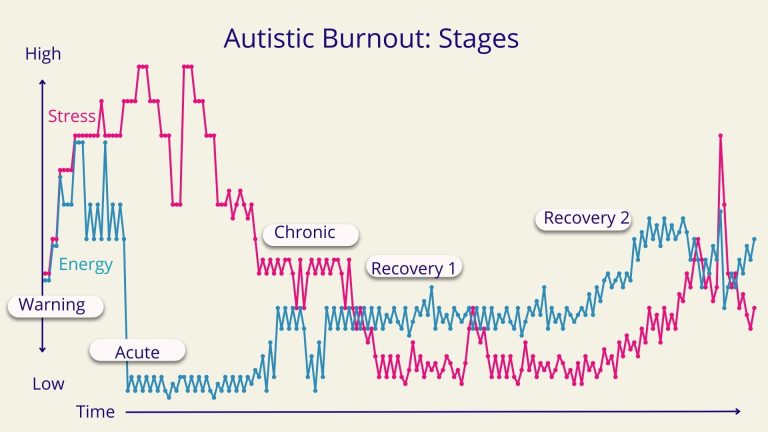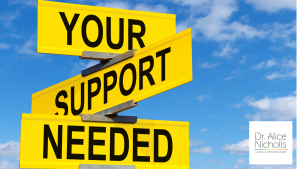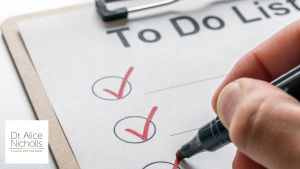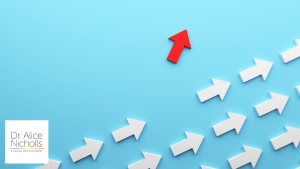Autistic Burnout is a clear sign that something needs to change in your life.
Often lots of things.
But where do you start?
The answer depends very much on where in the Cycle of Autistic Burnout you are right now.
In this article I will outline each stage of Autistic Burnout and what to focus on at each stage.

Figure 1. the stages of Autistic Burnout are shown here in terms of the relationship between stressors and energy.
The Warning Phase
What it looks like
In the beginning of this phase you will notice an increase in stress but feel able to manage it by increasing your (physical, mental, social, emotional or sensory) energy expenditure. In the short term this may feel manageable but as it goes on you will start to feel as if you are running on empty and you might start to notice fluctuations in your energy levels and ability to function.
- To acknowledge that you are highly stressed and that it is making you unwell regardless of how stressed you think you ‘should’ be or how hard you think other people are finding life.
- A reduction in stressors as soon as possible. This may not be possible if your stressors are things you can not change such as bereavement, health problems or something outside of your control, but it may help to:
- Take time off work (you don’t have to wait until you burnout to go off sick with stress)
- A reduction in responsibilities or workload (at home/work/school)
- Cancel/postpone/adjust/delegate tasks/jobs/events
- Lower standards where possible, for example housework, cooking
- Maintain or re-assert boundaries between home and work, housework and rest, time with people and time alone.
- Help from friends, family, colleagues or professionals
- To provide compassionate understanding
- To problem solve ways you might reduce stressors
- To provide practical support to reduce demands
- To lower their current expectations of your capacity
- To support you to access help for any physical or mental health needs that are going unmet
- Rest in whatever way you need, this may or may not be physical, cognitive, social, sensory, emotional
- Use whatever existing regulation skills you have. If something helps you to feel calmer and more regulated and isn’t causing you or someone else harm then please use it, even if it isn’t ideal
The Acute Phase
What it looks like
In this phase you will normally notice an intense crash in energy levels and ability to function.
This crash often occurs quite suddenly, although there may have been warning signs.
People often describe this phase as rock bottom, a crisis or deep burnout.
This phase can be horribly scary, confusing and disabling.
If this is you right now then please know that you have been too stressed for too long and with too little support.
It is not your fault that you have ended up in burnout.
Please be gentle with yourself. This phase in the Cycle of Autistic Burnout is something that needs to be survived and that survival doesn’t always look or feel the way you want it to, again this is not your fault.
None of this is ideal.
What helps
There are a few things that will help. I have written the list in a rough order of priority, so please try to start at the top and work your way down.
If it feels like too much to think about right now then bookmark this page and come back to it later.
- Know that this won’t last forever, this acute phase is horrible but normally within a few days or weeks people do start to get a little bit of energy and functioning back
- Prioritise survival, however you need to. It doesn’t need to be perfect, now is not the time to start something new (unless you really want to) or address bad habits unless they are an immediate risk to your health.
- Seek help for any acute or urgent physical or mental health problems it is not unusual to have flare ups of existing health problems or to discover entirely new ones during Autistic Burnout. Please get any new symptoms checked out by a medic and get in contact with local services if your mental health is deteriorating and/or you feel suicidal.
- Try to meet your basic needs, as well as you can, in anyway that you can. Again this is not the time for perfection, eat and drink what you can as long as it is not an immediate or serious risk to your health.
- Reduce/refuse/postpone any stressors wherever you can, allow yourself to take any help available in doing this.
- Each day ask yourself what is the absolute bare minimum you can get away with doing and try to do that
- Rest. Rest. Rest. however you need to, this may or may not be physical, cognitive, social, emotional or sensory.
- Engage in activities that regulate your sensory system (e.g. rocking, swinging, yoga, chewing, crunching, weighted blanket, body sock, walking)
- Focus on getting calmer rather than more energised (if you happen to get some energy somewhere then that’s great) the aim here is to get out of that state of threat caused by the stress that got you to this stage in the first place.
- Try to notice the things that help you to feel calmer, happier and those that give you a little more energy, make a note or take a photo of them to remind yourself.
- Allow yourself to use some of your very small energy budget on something you want to do/ watch/ listen to just because you want to rather than because you have to. This sends a signal to your nervous system that you are not in danger and can relax. You may also find it easier and have more energy for your hobbies and interests than you do anything else.
- Connect with people and/or animals you feel safe with in any way you have the energy for. Even if it’s just reading posts in an online support group, texting a friend or stroking your cat.
In the long term you can look at identifying your unmet needs and how you might build a lifestyle that is more sustainable and authentic for you but right now surviving needs to take priority.
You may not have the energy or capacity for joining an online community right now but if you do feel able to log into an online platform and have brief text based discussions you might like to consider joining Authenticity: Basecamp
Authenticity: Basecamp provides 90 days of support and a few brief on demand lessons to help you feel calmer, more regulated and more compassionate towards yourself during the early stages of recovery from Autistic Burnout.
The Chronic Phase
What it looks like
- Pacing: Aim to only spend about 60% of whatever energy you have each day. If you imagine your energy levels like a very over-drawn bank account, you are trying to reduce the debt, you will only do this by underspending or doing things that give you energy.
- Try to be a bit more compassionate towards yourself. You are doing the best you can despite a serious lack of resources (including but not limited to energy and support and possibly time and money).
- Identify stressors: You will likely be more aware than usual of small things that cause you stress. These might be things you were not aware of pre-burnout or things that you don’t think ‘should’ cause you stress. Either way, notice them, start to record them and where possible look at ways of reducing them.
- Meet your basic needs even if you are not aware of what they are. If you have poor interoception you might not know when you are hungry, tired or need the loo. If you think this is the case then you might find it helpful to schedule in or set reminders to meet your basic needs.
- Meet your sensory needs. You may already be aware of what you need to regulate your senses. However, if you are not you might benefit from adding in some sensory regulation strategies that tend to help regardless of sensory profile.
- Prioritise activities that help you to rest, regulate and/or give you energy. You may feel that you shouldn’t prioritise fun or non-essential activities, but these will help you to recover and start to make your life more sustainable.
- Find low-demand ways to connect with other people, nature or animals in a way that feels helpful to you.
- Pay attention to what makes you feel better and worse. You are likely to hear lots of advice from different people about what you need. It is all worth considering but please prioritise what you actually know about yourself. You are the expert in you and what you need.
If you would like my support in the chronic phase you have two options:
- Authenticity: Basecamp A 90 day support programme to help you get calmer, clearer and more supported. This is a supportive online community with regular text based prompts and a few short resources to help you with all of the above points.
- Authenticity: The course and community for Autistic people who want to live sustainable authentic Autistic lives without the burnout. This includes 12 months access to an online supportive community but has the additional benefit of a 12 module course which deep dives into identifying your needs and how to meet them. Although it is a deep dive the lessons are broken down into 10-15 minute chunks and there is no limit on how long you can take to complete it. If you are not sure which to chose I would suggest you take my free short course and see how accessible you find it. If it is manageable then I would recommend Authenticity: The Course and Community whereas if you find it is too much information to take on, even in small chunks but you don’t mind logging in, navigating the platform and reading some comments then you may be better suited to Authenticity: Basecamp.
Recovery 1 & 2
What it looks like
Recovery starts to happen when stress levels drop to a manageable level and you are using less energy than you are spending each day.
I have shown a difference in figure one between recovery 1 & 2 because initially this underspend of energy doesn’t lead to an increase in energy or a noticeable recovery. That is you might not notice an immediate increase in functioning in recovery 1.
Over time, as your mind, body, and nervous system get a chance to recover from the period of high stress and burnout you will notice an increase in energy and functioning and this is what I would describe as recovery 2.
During recovery 2 you will likely start to experience a gradual increase in energy and in functioning.
As with any increase in energy and functioning, there is a risk that you take on too much or others start placing too many demands on you. It is critical at this time to keep your stress levels well within your capacity. You are still recovering. What you have here, right now is an opportunity to make life more sustainable in the long term and avoid going back into the cycle of Autistic Burnout.
What helps
Here are some things that can help you to move through recovery and into a more sustainable life:
- Identify ways to gauge how much stress and energy you have.
- Maintain active awareness of your stress and energy levels by regularly checking in with yourself throughout the day.
- Continue to identify things that make you feel better and things that make you feel worse.
- Continue to develop self-compassion and consider the role of shame, self-criticism and internalised ablism in your life.
- Budget your different types of energy (physical, social, emotional, cognitive and sensory) each day
- In recovery 1 Aim to save 40% of what ever you start the day with.
- In recovery 2 aim to save 20% of whatever you start the day with. This will allow you to continue to build up some energy ‘equity’ so that when life happens and you end up having to spend 100% or even 120% it doesn’t set you right back into burnout.
- Create cushions of rest, soothing and regulating activities around tasks and events that cause your stress levels to rise.
- Take any increase in activity and demands slowly and gently.
- If you haven’t already then start to identify your sensory needs and build regulating activities and supports into your daily activities.
- Identify whether interoception is something you struggle with and build in interoceptive supports and activities to help improve your interoceptive awareness.
- Identify how you personally experience connection and find low demand ways of accessing it regularly.
- Identify adjustments that would help you at work, home and socially and start to find ways of asking for them.
- Examine how you mask and where and with whom it would be safe to mask less.
- Consider what is important to you in your life and what your values are and use these to guide you towards living a more authentic, sustainable life.
If you would like my help with these tasks then you would be very welcome to join Authenticity: The course and community where you will be guided through these activities step by step at your own pace and have access to a supportive community where you can check-in, ask questions and meet other Autistic people going through the same process.
I am an Autistic Clinical Psychologist specialising in Autistic Burnout if you would like to know more about my work please check out my:
- Mailing list community for people who want to receive helpful information and resources about Autistic Burnout.
- Free short course on How to Break the Cycle of Autistic Burnout (link goes straight to registration page)
- Authenticity Basecamp: A 90 day support programme for people in the early stages of recovering from Autistic Burnout who want to get calmer, clearer and more supported.
- Authenticity: The Course and Community: For late-realised, high-masking Autistic adults who want to build more sustainable, authentic lives and break free of the cycle of Autistic Burnout for good.
